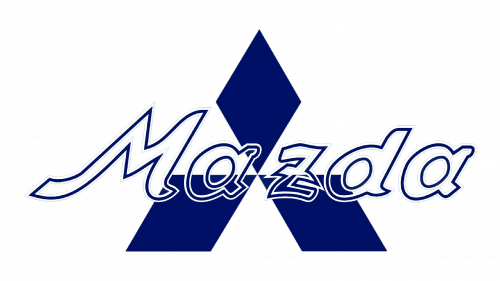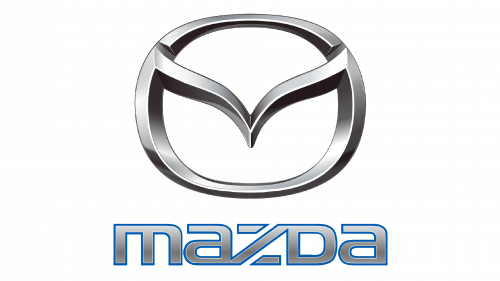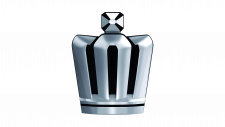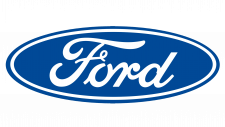Mazda Logo
The Japanese company Mazda Motor Corporation, headquartered in Hiroshima, manufactures automobiles. A very extensive range of Mazda vehicles includes SUVs, roadsters, minivans, and pickups. The main focus is on small and medium-sized cars. Mazda’s numerous assembly plants in more than twenty countries enable it to export its products extensively, making Mazda a world-class car manufacturer.
Meaning and History
The brand’s roots go back to 1920, but it originally produced cork products and was called Toyo Cork Kogyo. The founder was Jujiro Matsuda, the son of a fisherman. In the early 30s, the first three-wheeled cargo scooters called Mazdago were seen on the streets. During the war, Mazda also produced weapons for the Japanese military. After the war, the first trucks went for sale. Passenger cars left the assembly lines only in 1960. The year 1967 marked the start of the full-scale export of Mazda vehicles to Europe. Now, Mazda’s brand includes passenger cars, sports cars, crossovers, and even pickup trucks. The name Mazda comes from the name of the supreme Zoroastrian god Ahura Mazda.
What is Mazda?
Mazda is a Japanese automobile company. It all started with cork products but transformed into a multinational automotive manufacturing company.
1920 – 1928
A black and white geometric shape represented the company initially. It was round with four blades on the outer edge, which remind of shuriken. The center part had a circle cut in half with two horizontal lines separating the two halves, along with some other small details.
1928 – 1931
A much-simplified version of the previous logo was presented in 1928. It was a red circle with a white center. The circle had two horizontal lines coming from the sides and almost meeting in the center. In a way, it looked like some kind of road sign.
1931 – 1934
A more recognizable Mazda logo appeared in 1931. The main colors were blue and white. The name was done in beautiful cursive writing with a blue outline with a barely noticeable gray border on the outer and inner edge. The letters themselves were white. A white triangle that had three blue diamond shapes coming out of the center was behind it.
1934
The wordmark from the previous logo was slightly adjusted and used separately. It was completely black with white. The letters were drawn thinner in some places.
1934 – 1936
The wordmark was redone in blue. It was still a name in cursive handwriting, but the ends of each letter were sharp. The word was italicized. The new emblem had a sophisticated and polished appearance.
1936 – 1959
Three black lines that had two peeks in the middle, which resembled the letter “M”, created a new logo. The three “M”s represented the name – Mazda Motor Manufacturer. Each line got shorter and every letter decreased in size. The ends of the lines were cut at a diagonal, so the lines were forming a “V”.
1951 – 1972
The name served as the logo once again. The word “Mazda” was done using bold Japanese katakana characters. They were done in black and had straight lines and sharp ends.
1954 – 1974
The brand returned to an English version. The wordmark was blue. The italicized letters had straight lines of various thicknesses. Only the letter “D” had rounded elements. The “A”s had the horizontal line sticking out on the right. It looked dynamic and timeless.
1959 – 1974
The wordmark was done in a darker shade of blue. A red, round emblem accompanied the wordmark. It had a thin ring and lowercase letter “M’ that had the two ends stretched out in opposite directions so they were touching the ring. The logo looked bolder and more impressive.
1975 – 1991
There were not a lot of changes done as the name of the company remained the only element of the logo. The light blue typeface was quite unique, though. It was a mix of uppercase and lowercase letters of the same height. They were touching and had round and straight corners. The letter “Z” had horizontal lines that were detached from the diagonal line.
1991 – 1992
The well recognizable wordmark introduced in 1975 was once again accompanied by an emblem. It was an oval ring with varying thickness. A diamond shape with a white center was placed inside and touched the bottom of the oval. Similar to the oval figure, it was thicker at the bottom.
1992 – 1997
The logo has not really changed except for the emblem. The diamond shape was rounded and had a circle inside of it.
1997 – 2015
The new winged logo of the Mazda brand is a stylized image of a Zoroastrian deity, which it is named after. It replaced the emblem above the wordmark, which was smaller compared to the geometric shape above it. The new emblem had a metallic look thanks to gray and black gradients. The oval shape along with the winged “V” inside had smooth lines and a 3D appearance.
2015 – 2018
The oval emblem had a lighter gradient of gray and looked smaller compared to the previous logo. The wordmark was also done in a light gray gradient. The blue color seen in previous versions was used as a thin outline for the letters.
2018 – 2024
The brand stayed true to the logo introduced back in 1997 and only slightly modified it. The oval emblem was darker once more. The blue border around the letters was replaced by a gray one. The letters acquired a 3D, metallic look similar to the emblem above it, which created a more cohesive picture and made the logo look even more sophisticated.
2024 – Today
In 2024 the Mazda logo got sharper and stronger, being redrawn in a two-dimensional manner, with flat black lines against a transparent background. The contours of the emblem remained the same, but in a new style they became more distinctive, and the central part of the image — more triangular. This redesign has signified the new era of the company’s development and its readiness to grow and change.
Font and Color
Originally, the wordmark was very elegant, cursive handwriting. For twenty years, it was replaced by a font that had straight, clean lines. Since 1975, the recognizable logo used a modified version of the Handel Gothic font. With an exception of a red color seen in one of the logos, the company used various shades of black color for its logo that was later replaced by a blue as well as a combination of two colors.



























